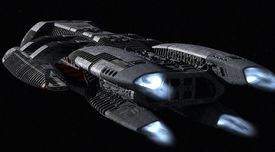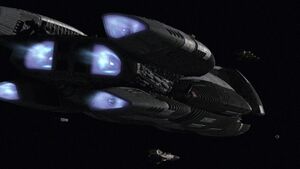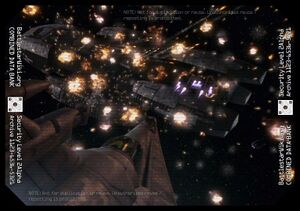Galactica type battlestar
More actions
- This article discusses the original battlestar class (of which Galactica is a member) of the re-imagined series. For information on the battlestars of the Original Series, see Battlestar (TOS). For information on the newer Mercury class battlestars, see Mercury class battlestar.
| Battlestar (Galactica type) | |||
|---|---|---|---|

| |||
| Race: | Colonial | ||
| Type: | Military | ||
| FTL: | Yes | ||
| Propulsion: | |||
| Crew: | over 2,800 | ||
| Capacity: | |||
| CO: | |||
| XO: | |||
| Role: | Carrier / battleship hybrid | ||
| Weapons: | Primary and point-defense Kinetic Energy Weapons, conventional missiles, nuclear warheads, Vipers, Raptors | ||
| Armaments: | {{{arm}}} | ||
| Defenses: | {{{def}}} | ||
| Aircraft: | {{{aircraft}}} | ||
| Aviation facilities: | {{{facilities}}} | ||
| Fate: | Active (following heavy refits, with one exception) | ||
| Emblem: | [[Image:{{{patch}}}|175px|Ship's patch]] | ||
| Other Images: | Gallery | ||
| Length: | {{{length}}} | ||
| Width: | {{{width}}} | ||
| Height: | {{{height}}} | ||
| Weight: | {{{weight}}} | ||
| Wingspan: | {{{wingspan}}} | ||
| Other: | {{{otherdi}}} | ||
| Cost: | {{{construction}}} | ||
| Construction Time: | {{{construction}}} | ||
| Hull Size: | {{{hull size}}} | ||
| Hull: | {{{hull}}} | ||
| FTL Cooldown: | {{{ftl cooldown}}} turns | ||
| Speed: | {{{speed}}} m/s | ||
| Turn Rate: | {{{turn rate}}}°/turn | ||
| Armor Total: | {{{armor total}}} | ||
| Armor Left: | {{{armor left}}} | ||
| Armor Right: | {{{armor right}}} | ||
| Armor Front: | {{{armor front}}} | ||
| Armor Rear: | {{{armor rear}}} | ||
| Armor Top: | {{{armor top}}} | ||
| Armor Bottom: | {{{armor bottom}}} | ||
| DRADIS Range: | {{{dradis range}}} m | ||
| Processing Power: | {{{processing power}}} | ||
| Munition Slots: | {{{munitions}}} | ||
| Munition Cooldown Period: | {{{munition cooldown}}} turns | ||
| Squadron Slots: | {{{squadrons}}} | ||
| Squadron Size: | {{{squadron size}}} | ||
| Special Abilities: | {{{special abilities}}} | ||
| Additional Information | |||
Overview

The Galactica type battlestar is a capital Colonial warship that combines the functions of aircraft carrier and battleship. The first twelve battlestars were laid down in the early days of the Cylon War, each representing one of the Twelve Colonies (Miniseries). This article concerns that original, and unnamed, class.
Following the end of the war, the original battlestars remained in service, and many newer battlestars were built. At the time of the Fall of the Twelve Colonies, the newer Mercury class represented the top of the line.
The original battlestars were space-going leviathans of some 4,640ft (1,547m) in length, housing at least 4 squadrons of 20 Viper space superiority fighters apiece and nuclear warheads. A fully-armed battlestar is capable of a wide range of offensive actions, while her defensive armaments ensure she is fully capable of both protecting herself from attack and engaging an enemy at close quarters.
Layout
The design common to Galactica and her sister ships can be broken down into two main sections: the main hull, and the twin flight pods.
Main Hull
This comprises the bulk of a battlestar and can itself be divided into three sections:
The "alligator head" contains water storage tanks (Water).
The midships area contains the pod retraction mechanisms and crossways linking the hanger pods for the transfer of equipment and personnel (Miniseries).
The stern section contains sublight engines, FTL drive coils, etc. Four of the sublight engines are in engine pods, and two more are between the pods.
Flight Pods
The flight pods are mounted on either side of the hull and contain a battlestar's Vipers and Raptors. During normal operations, they are extended away from the main hull. During FTL jumps, the pods are retracted against the hull, concealing their open ends and making launches and landings impossible. Each pod comprises two main decks for flight operations: the upper landing bay, which extends the full length of the pod, and the lower launch bays, which provide some 40 launch tubes per pod.[citation needed]
Landing approachs are made from the stern. The preferred approach is a slow run into the landing bay, prior to making a vertical landing on a defined landing area (Act of Contrition). However, in emergencies, combat landings can be made, in which a craft approaches at speed and makes a running landing on its undercarriage (Miniseries).
The forward end of the landing bay also serves as a launch area for Raptors and shuttles. The landing bay is large enough to accept a variety of other Colonial vessels, at least as large as "heavy" passenger ships such as Colonial Heavy 798 (Miniseries). Docking collars are located throughout the upper sections of the landing bay in order to provide a pressurized connection between a docked vessel and the battlestar.[citation needed] The flight pods also have docking ports to dock with larger ships or stations.
The hangar deck is used for maintenance, repair, refueling, rearming, and launch operations. The hangar deck runs the length of the flight pod, but can be divided and sealed off into five sections for damage control purposes.[citation needed] Viper flight operations are overseen by a Landing Signal Officer.
Specifications
Dimensions

Hull:
- Length: 4,640ft (1.414m)
- Beam: 1,820ft (555m) (flight pod to flight pod - extended)
- Draft: 580ft (177m) (source: SciFi.com)
Flight Pods:
- Length (approx): 2,019ft (615m)
- Beam (approx): 360ft (110m)
- Draft (approx): 211ft (64m) Template:Ref
An appreciation of the size of an original battlestar can be gleaned from a comparison to current Earth craft. A battlestar is over 4 times longer than a Nimitz class nuclear carrier of the US Navy. The flight pod of an original battlestar is almost twice the length of Nimitz, is some 150ft (46m) wider, and is approximately as tall as the Nimitz is from waterline to the top of the tower. An original battlestar's "alligator head" is as broad as the flight deck of Nimitz is long. Each of the nacelles of an original battlestar's outer four sublight engines is large enough to contain Nimitz.
Propulsion

- at least 2 FTL drivesTemplate:Ref
- 6 sublight engines
- 4 in individual engine pods
- 2 on main hull between engine pods
- 40 x maneuvering engines (in 10 clusters of 4 apiece)Template:Ref
Despite their massive size, battlestars are extremely maneuverable and can dock with space stations such as Ragnar Anchorage. Battlestars are not designed for atmospheric flight, although their hulls can manage a tenuous upper atmospheric storm like that surrounding the gas giant Ragnar (Miniseries). A battlestar's FTL systems are capable of accurate jumps, able to place them in synchronous orbit above a relatively close planet (Miniseries) and of placing them safely in the midst of an asteroid field (The Hand of God) or a dense fleet of ships (Scattered). However, they are grossly inferior to Cylon systems in safe range (Kobol's Last Gleaming, Part I).
Endurance
Battlestars are intended to operate for long periods without re-supplying. Their water purification capabilities alone are so efficient that, barring an emergency or unforeseen event, a battlestar can operate "for several years before replenishing" (Water). They also appear capable of undertaking large-scale repairs following battle damage (Miniseries, Water). They have ammunition assembly capabilities in the armory (Epiphanies) and may have small general fabrication facilities (Litmus). Vegetable stores and canned goods are kept in titanium lockers (Final Cut).
Computer Systems
The original battlestar vessels deliberately avoided the use of networked primary computer systems during the Cylon War, as Cylon forces were adept at infiltrating and subverting such systems (Miniseries).
On Galactica, in the post-Cylon War era, these primary computers remained isolated by practice on order of its last pre-Holocaust commanding officer, William Adama. This no-networks practice likely saved Galactica from the fate of its sister battlestars in the Fall of the Twelve Colonies as Galactica's no-network order meant that the CNP, installed in almost all Colonial Fleet vessels at the time, could not be used aboard Galactica as the CNP was designed for use with a computer network.
In one dire instance in the early months of their exodus, Galactica networks its primary computers temporarily to aid in computation speeds for Jump calculations needed to find the missing civilian Fleet (Scattered), but it is not without consequence. One or more computers are cracked during a Cylon attack with a Cylon virus, which proves resistant to removal and (weeks later) threatens the operation of the battlestar until the computers' hard drives are erased and restored from pre-Fall backup sets (Flight of the Phoenix).
Armament

- 24 large gun turrets (mounting 2 guns apiece)Template:Ref
These are mounted on the dorsal and ventral surfaces of the main hull and the ventral surface of the bow. The two guns on each turret fire in tandem. They have been shown to be quite effective against targets like basestars (Resurrection Ship, Part II).
- Numerous smaller turrets (mounting 2 guns apiece)Template:Ref
These are mounted on the flight pods and other surfaces. Each barrel fires explosive rounds in bursts.
- Multiple nuclear warheadsTemplate:Ref
The delivery system for the nuclear warheads is unknown.
- At least 4 squadrons of 20 Viper space superiority fightersTemplate:Ref
Even the latest Mk. VII Vipers remain compatible with this class's launch and recovery facilities.
- Numerous Raptor multi-role vehiclesTemplate:Ref
Crew
Galactica's crew complement prior to her scheduled decommissioning was approximately 2,800.Template:Ref This figure is likely higher for a fully staffed, operational battlestar.
Life Support
Approximately twelve oxygen recirculation units are mounted throughout the ship, which replenish oxygen as well as remove ("scrub") carbon dioxide from the air. These devices work continuously (Final Cut).
Sources
- Template:Note Calculated based on elevations made available by Zoic.
- Template:Note Tigh: "Engineering/Combat. Please spin up FTL drives One and Two." (Miniseries)
- Template:Note Originally sourced to Zoic without explanation.
- Template:Note These have been referred to as railguns by some fan sources, but there is substantial evidence to the contrary. See Railgun for more.
- Template:Note Unsourced figures have ranged from 252 to 512. According to the BSG Magazine, the number is 504.
- Template:Note As of the episode "Bastille Day", Galactica was equipped with five nuclear warheads. This may be lower than the typical number, since Galactica was in the process of being decommissioned and had already had most of its ammunition removed. If this is the case, we must conclude that Galactica was unable to reload its supply of nuclear arms at Ragnar Anchorage (a sensible proposition, given the ease with which purported arms smuggler Leoben Conoy was able to gain access to the facility).
- Template:NoteAfter the destruction of 20 Vipers during the Cylon Attack, Galactica was still able to muster a 40-Viper strong defensive screen by combining their remaining squadron of Mk. VII vipers with a full squadron of Mk. II vipers from a museum exhibit in the starboard flight pod. This suggests that Galactica, with a single operational flight pod, was fielding two squadrons from it, and that when fully operational it could have fielded an additional two squadrons from the starboard pod as well.
- Template:NoteAt the time of the Cylon Attack, Galactica was apparently equipped with at least eight. See Galactica Raptor tally for a running count.
- Template:Note See Galactica crew count.
